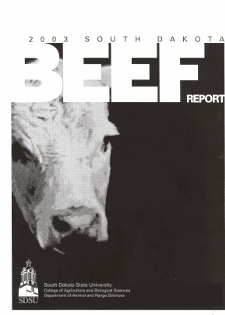Document Type
Report
Report Number
2003-13
Publication Date
2003
Keywords
feedlot, copper, zinc, selenium, mineral status
Summary
The objective of this study was to determine the effects of trace mineral inclusion management on the performance and mineral status of newly received feeder calves. Steers from 2 pastures at a single ranch in Western South Dakota blocked into non-implanted (NI; n = 64; BW = 240 kg), May implanted (MI; n = 64; BW 252 kg;) and August implanted (AI; n = 66; BW = 248 kg;) groups, then allotted to one of two treatment groups. Treatments consisted of either: a pelleted supplement fed at a fixed amount to meet the gram / daily requirement (GDR) of Cu (as CuSO4) and Zn (as ZnSO4) of a growing steer or as a percent of the diet (PER). Liver biopsy and blood samples were collected at the initiation of the trial and again after 28 d on feed. The ADG and feed conversion (F/G) was not affected by diet treatment. Cumulative DMI tended to be greater (P < 0.10) in PER diets (7.31 vs. 7.12 kg). Steers receiving PER treatments tended (P < 0.11) to have less of a decrease in hepatic Zn than GDR treatments. The change in hepatic K was affected (P < 0.05) by implant with AI steers having the greatest increase. These results suggest that if performance and morbidity are enhanced by feeding Cu and Zn to meet the gram daily requirement of the animal, then Cu and Zn may need to be fed at a greater level to see any differences from this practice.
Number of Pages
7
Format
application/pdf
Language
en
Publisher
South Dakota State University
Rights
Copyright © 2003 South Dakota State University
Recommended Citation
Blalock, Howard M.; Pritchard, Robbi H.; and Epperson, William, "The Effects of Trace Mineral Inclusion Management on the Performance and Mineral Status of Newly Recwived Feeder Calves" (2003). South Dakota Beef Report, 2003. 14.
https://openprairie.sdstate.edu/sd_beefreport_2003/14


